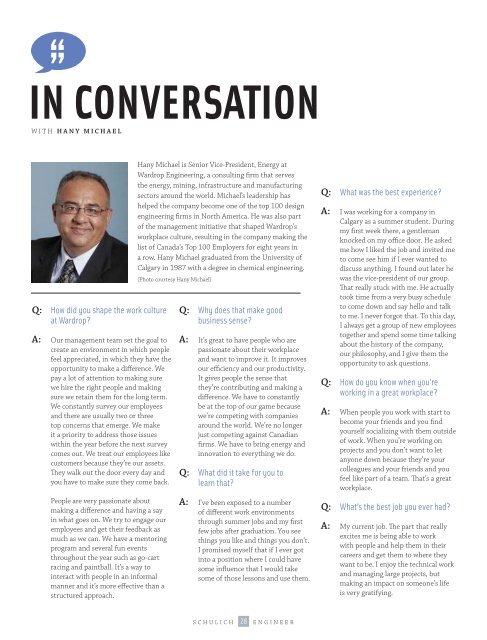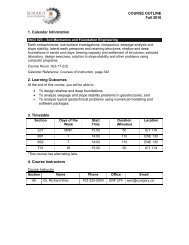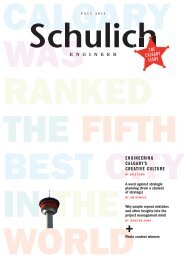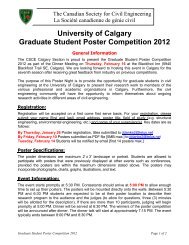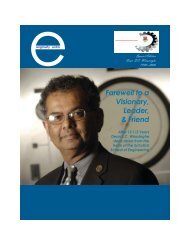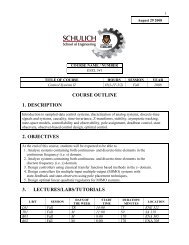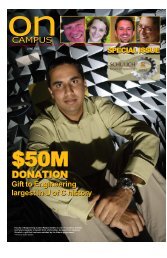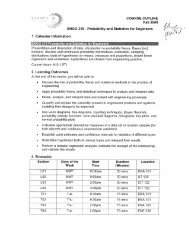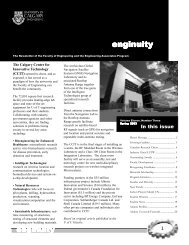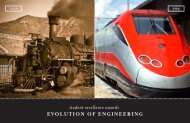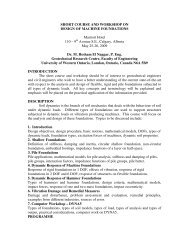high performance - The Schulich School of Engineering - University ...
high performance - The Schulich School of Engineering - University ...
high performance - The Schulich School of Engineering - University ...
- No tags were found...
You also want an ePaper? Increase the reach of your titles
YUMPU automatically turns print PDFs into web optimized ePapers that Google loves.
IN CONVERSATIONWITH HANY MICHAELQ: How did you shape the work cultureat Wardrop?A: Our management team set the goal tocreate an environment in which peoplefeel appreciated, in which they have theopportunity to make a difference. Wepay a lot <strong>of</strong> attention to making surewe hire the right people and makingsure we retain them for the long term.We constantly survey our employeesand there are usually two or threetop concerns that emerge. We makeit a priority to address those issueswithin the year before the next surveycomes out. We treat our employees likecustomers because they’re our assets.<strong>The</strong>y walk out the door every day andyou have to make sure they come back.People are very passionate aboutmaking a difference and having a sayin what goes on. We try to engage ouremployees and get their feedback asmuch as we can. We have a mentoringprogram and several fun eventsthroughout the year such as go-cartracing and paintball. It’s a way tointeract with people in an informalmanner and it’s more effective than astructured approach.Hany Michael is Senior Vice-President, Energy atWardrop <strong>Engineering</strong>, a consulting firm that servesthe energy, mining, infrastructure and manufacturingsectors around the world. Michael’s leadership hashelped the company become one <strong>of</strong> the top 100 designengineering firms in North America. He was also part<strong>of</strong> the management initiative that shaped Wardrop’sworkplace culture, resulting in the company making thelist <strong>of</strong> Canada’s Top 100 Employers for eight years ina row. Hany Michael graduated from the <strong>University</strong> <strong>of</strong>Calgary in 1987 with a degree in chemical engineering.(Photo courtesy Hany Michael)Q: Why does that make goodbusiness sense?A: It’s great to have people who arepassionate about their workplaceand want to improve it. It improvesour efficiency and our productivity.It gives people the sense thatthey’re contributing and making adifference. We have to constantlybe at the top <strong>of</strong> our game becausewe’re competing with companiesaround the world. We’re no longerjust competing against Canadianfirms. We have to bring energy andinnovation to everything we do.Q: What did it take for you tolearn that?A: I’ve been exposed to a number<strong>of</strong> different work environmentsthrough summer jobs and my firstfew jobs after graduation. You seethings you like and things you don’t.I promised myself that if I ever gotinto a position where I could havesome influence that I would takesome <strong>of</strong> those lessons and use them.Q: What was the best experience?A: I was working for a company inCalgary as a summer student. Duringmy first week there, a gentlemanknocked on my <strong>of</strong>fice door. He askedme how I liked the job and invited meto come see him if I ever wanted todiscuss anything. I found out later hewas the vice-president <strong>of</strong> our group.That really stuck with me. He actuallytook time from a very busy scheduleto come down and say hello and talkto me. I never forgot that. To this day,I always get a group <strong>of</strong> new employeestogether and spend some time talkingabout the history <strong>of</strong> the company,our philosophy, and I give them theopportunity to ask questions.Q: How do you know when you’reworking in a great workplace?A: When people you work with start tobecome your friends and you findyourself socializing with them outside<strong>of</strong> work. When you’re working onprojects and you don’t want to letanyone down because they’re yourcolleagues and your friends and youfeel like part <strong>of</strong> a team. That’s a greatworkplace.Q: What’s the best job you ever had?A: My current job. <strong>The</strong> part that reallyexcites me is being able to workwith people and help them in theircareers and get them to where theywant to be. I enjoy the technical workand managing large projects, butmaking an impact on someone’s lifeis very gratifying.HIGHPERFORMANCEHEALTHBY PETER CALAMAIBIOMEDICAL ENGINEERS SHARE A COMMON PASSION – THEY LOVE TO SOLVE THEPROBLEMS OF THE HUMAN BODY BY APPLYING ENGINEERING PRINCIPLES.<strong>The</strong> problems are as complex andmultifaceted as the body itself. At the<strong>University</strong> <strong>of</strong> Toronto, Molly Shoichetis collaborating on research to deliverbiological “factors” or compoundsthat would stimulate stem cells tobegin repairs after spinal columninjuries or strokes. At the ÉcolePolytechnique in Montreal, MichaelBuschmann invented a cartilagerepair technology. BioSyntechCanada is winding up successfultrials <strong>of</strong> Buschmann’s processwhich involves a therapeuticbiomaterial that improves theregeneration <strong>of</strong> knee cartilage,thereby reducing knee pain andpossibly preventing the onset <strong>of</strong>osteoarthritis and the need for jointreplacement surgery.At the <strong>Schulich</strong> <strong>School</strong> <strong>of</strong> <strong>Engineering</strong>,Carolyn Anglin and colleagues are puttingthe finishing touches on a computer-assistedsurgery technique that aims to greatly reducethe post-operative pain <strong>of</strong>ten experiencedafter knee replacement operations.Such imaginative passion combined withincreased funding and rapid advances insome foundational sciences has madebiomedical engineering a hot researcharea across North America. In Canadaspecifically, the federal governmentin September 2008 endorsedbiomedical engineering and medicaltechnologies as one <strong>of</strong> four healthpriorities in the national science andtechnology strategy. In response,the current five-year strategic plan<strong>of</strong> the Canadian Institutes <strong>of</strong> HealthResearch, the main federal fundingagency in the health sciences,pledges to “support research at theinterface between the biological andthe physical and applied sciences.”Biomedical engineering is a disciplinewith ancient roots (a leather and woodartificial toe was found on an Egyptianmummy dating from between 1069 and 664BC) but associated largely in the public mindwith similar prostheses and medical deviceslike heart pacemakers. So what’s lately made itso exciting? >>SCHULICH28 ENGINEERSCHULICH 29 ENGINEER


